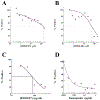Identification and Characterization of Chemical Compounds that Inhibit Leucyl-tRNA Synthetase from Pseudomonas aeruginosa
- PMID: 30088448
- PMCID: PMC6367055
- DOI: 10.2174/1570163815666180808095600
Identification and Characterization of Chemical Compounds that Inhibit Leucyl-tRNA Synthetase from Pseudomonas aeruginosa
Abstract
Background: Pseudomonas aeruginosa is an opportunistic multi-drug resistance pathogen implicated as the causative agent in a high-percentage of nosocomial and community acquired bacterial infections. The gene encoding leucyl-tRNA synthetase (LeuRS) from P. aeruginosa was overexpressed in Escherichia coli and the resulting protein was characterized.
Methods: LeuRS was kinetically evaluated and the KM values for interactions with leucine, ATP and tRNA were 6.5, 330, and 3.0 μM, respectively. LeuRS was developed into a screening platform using scintillation proximity assay (SPA) technology and used to screen over 2000 synthetic and natural chemical compounds.
Results: The initial screen resulted in the identification of two inhibitory compounds, BT03C09 and BT03E07. IC50s against LeuRS observed for BT03C09 and BT03E07 were 23 and 15 μM, respectively. The minimum inhibitory concentrations (MIC) were determined against nine clinically relevant bacterial strains. In time-kill kinetic analysis, BT03C09 was observed to inhibit bacterial growth in a bacteriostatic manner, while BT03E07 acted as a bactericidal agent. Neither compound competed with leucine or ATP for binding LeuRS. Limited inhibition was observed in aminoacylation assays with the human mitochondrial form of LeuRS, however when tested in cultures of human cell line, BT03C09 was toxic at all concentration whereas BT03E07 only showed toxic effects at elevated concentrations.
Conclusion: Two compounds were identified as inhibitors of LeuRS in a screen of over 2000 natural and synthetic compounds. After characterization one compound (BT03E07) exhibited broad spectrum antibacterial activity while maintaining low toxicity against human mitochondrial LeuRS as well as against human cell cultures.
Keywords: E. coli; Pseudomonas aeruginosa; antibiotics; drug discovery; leucyl-tRNA synthetase; protein synthesis..
Copyright© Bentham Science Publishers; For any queries, please email at epub@benthamscience.net.
Conflict of interest statement
CONFLICT OF INTEREST
The authors declare no conflict of interest, financial or otherwise.
Figures





References
-
- Giamarellou H, Kanellakopoulou K. Current therapies for Pseudomonas aeruginosa. Crit Care Clin 2008; 24: 61–78. - PubMed
-
- Breidenstein EB, Fuente-Nunez C, Hancock RE. Pseudomonas aeruginosa: all roads lead to resistance. Trends Microbiol 2011; 19: 419–26. - PubMed
-
- Eriani G, Delarue M, Poch O, Gangloff J, Moras D. Partition of tRNA synthetases into two classes based on mutually exclusive sets of sequence motifs. Nature 1990; 347: 203–6. - PubMed
-
- Jakubowski H Quality control in tRNA charging. Wiley Interdiscip Rev RNA 2012; 3: 295–310. - PubMed
-
- Crepin T, Schmitt E, Mechulam Y, et al. Use of analogues of methionine and methionyl adenylate to sample conformational changes during catalysis in Escherichia coli methionyl-tRNA synthetase. J Mol Biol 2003; 332: 59–72. - PubMed
Publication types
MeSH terms
Substances
Grants and funding
LinkOut - more resources
Full Text Sources
Other Literature Sources
Medical
Molecular Biology Databases

